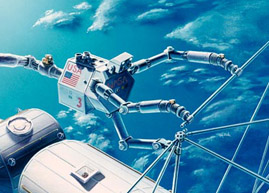Astronauts of the future, meet your competition: When the space shuttle Discovery launches later today, Robonaut 2 (R2)�seen above on the left�will become the first humanoid robot in space.
R2 is bound for the International Space Station, and scientists will spend a year simply studying how well the robot moves in zero G. Once mission managers are satisfied, the android will be assigned one of its first tasks: house cleaning.
To keep the crew healthy, astronauts on the ISS have to use disinfecting wipes on all handrails every week. “Jobs like that are really crummy for humans,” said Robert Ambrose, the Robonaut project leader at NASA’s Johnson Space Center in Texas. Fortunately for the ISS crew, R2 wasn’t programmed for snarky backtalk.
Besides, Ambrose said, “we’re designing [Robonaut] for EVA”�extravehicular activity, the NASA term for spacewalking�”and you can’t really hear your robot crack jokes in a vacuum.”
These days, plenty of robots have landed on other planets and been put to work. Still, building a machine that can operate in microgravity around humans but without human control was a unique challenge. The mature, responsible R2 owes its shot at glory in space to a host of robotic “ancestors,” earlier androids that never left Earth as well as less human-like machines that are already hard at work on the ISS.

0 Comments Leave a comment